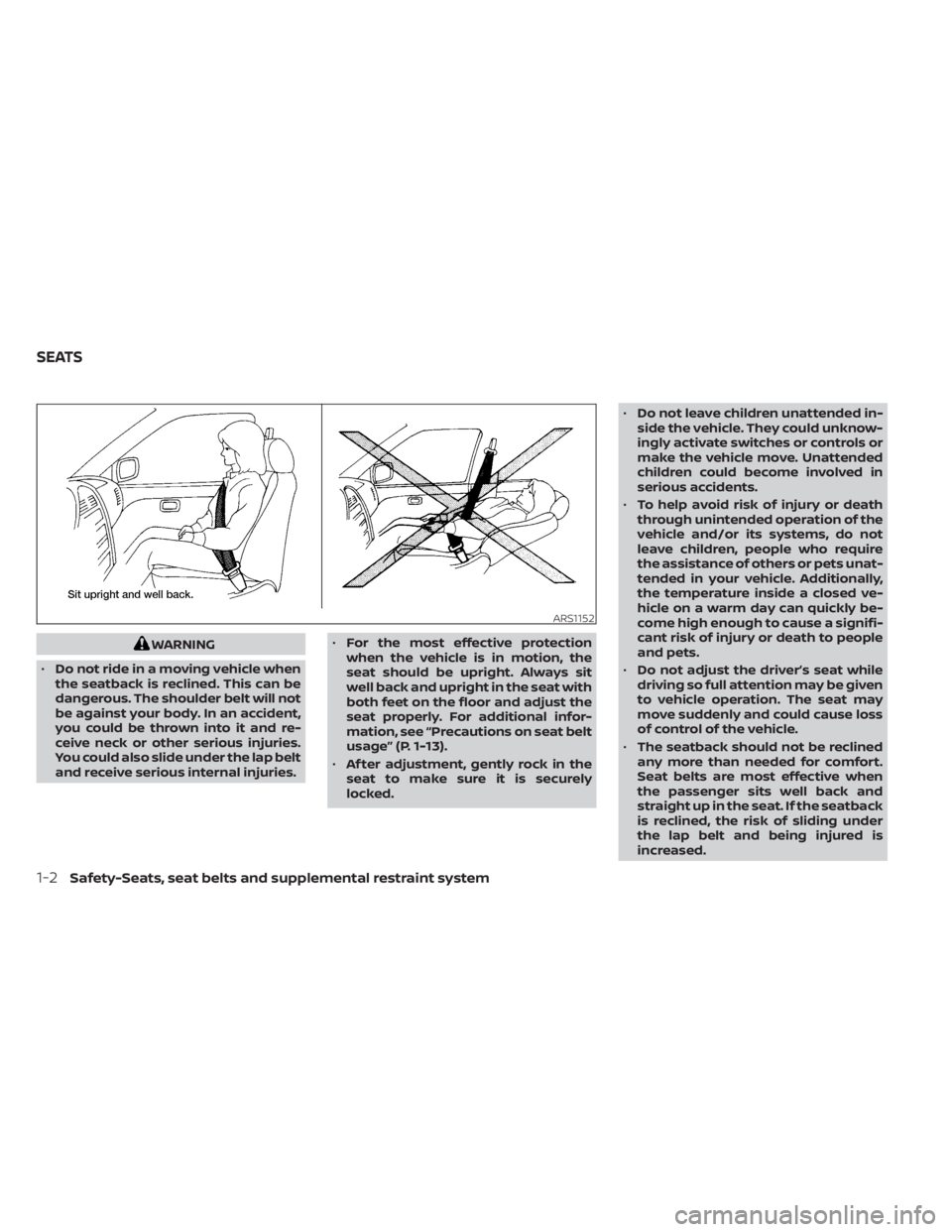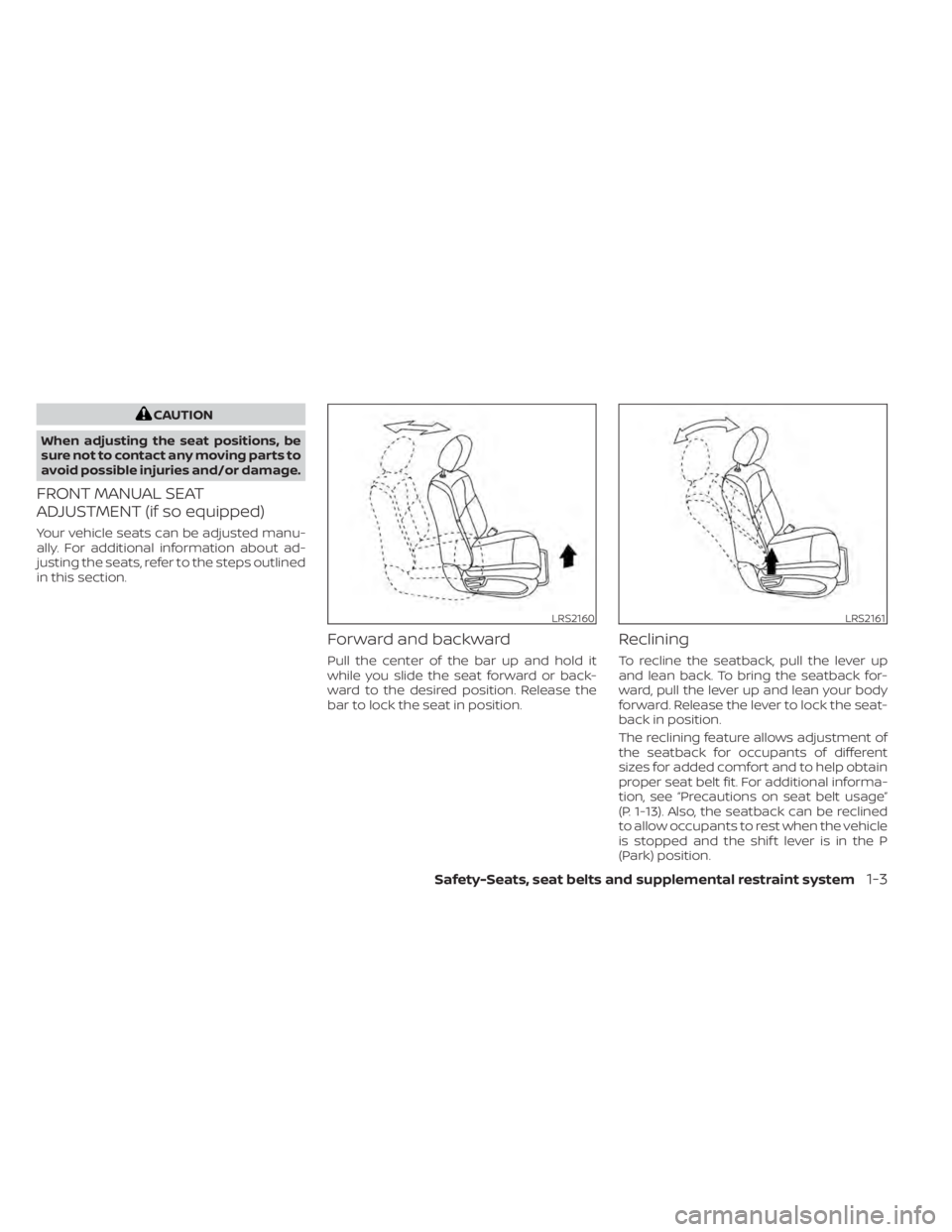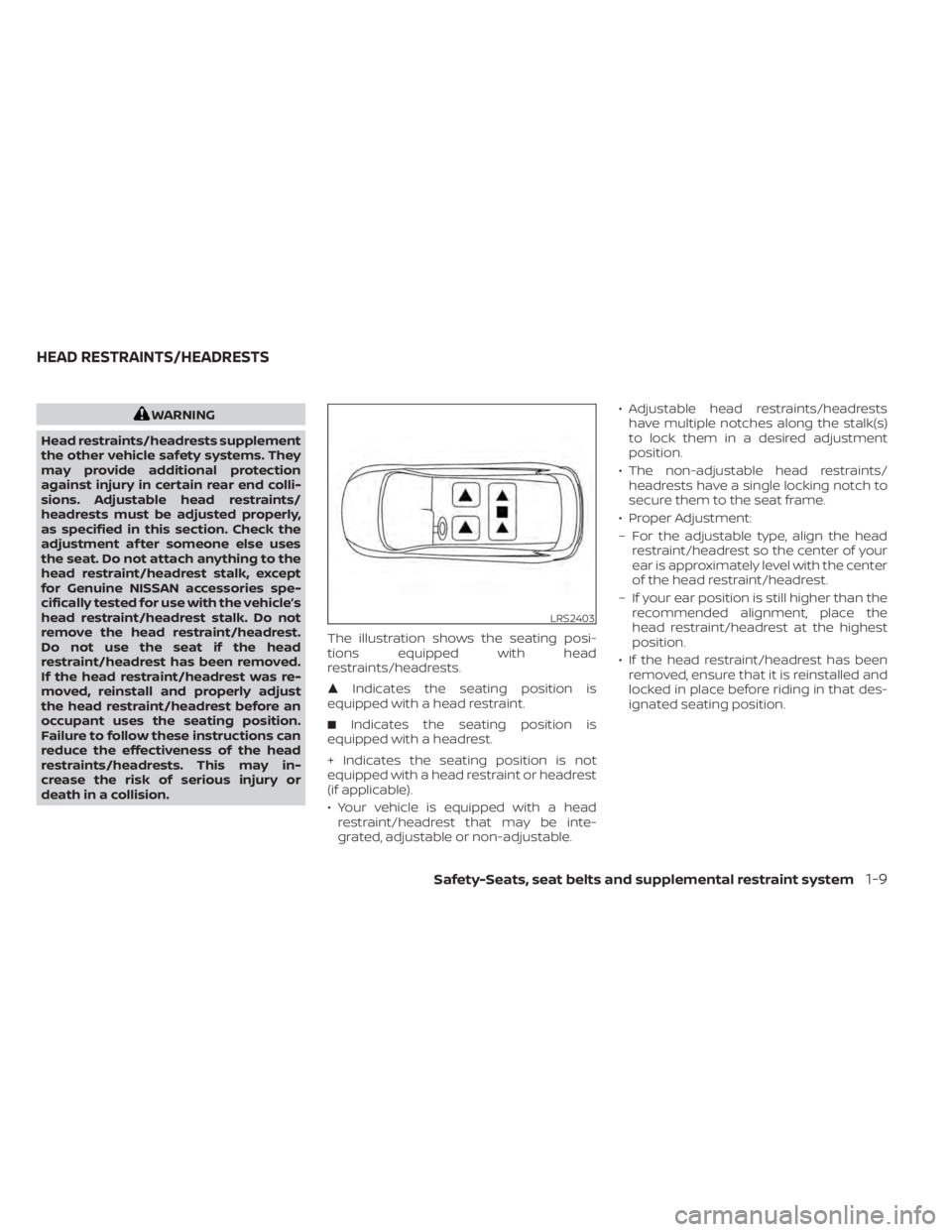Page 7 of 508
Safety-Seats, seat belts and supplemental restraint system
Instruments and controls
Pre-driving checks and adjustments
Monitor, climate, audio, phone and voice recognition systems
Starting and driving
In case of emergency
Appearance and care
Do-it-yourself
Maintenance and schedules
Technical and consumer information
Index
0
1
2
3
4
5
6
7
8
9
10
11
Page 17 of 508
Brake warning
light2-9
Charge warning
light2-10
Engine oil pres-
sure warning light2-10
Master warning
light2-10
Seat belt warning
light and chime2-10
Supplemental air
bag warning light 2-11
Anti-lock Braking
System (ABS)
warning light2-11
Front passenger
air bag status
light2-12
Low tire pressure
warning light
2-12
Malfunction Indi-
cator Light (MIL) 2-13
Master warning
light2-14
WARNING AND INDICATOR LIGHTS
Illustrated table of contents0-9
Page 20 of 508

WARNING
• Do not ride in a moving vehicle when
the seatback is reclined. This can be
dangerous. The shoulder belt will not
be against your body. In an accident,
you could be thrown into it and re-
ceive neck or other serious injuries.
You could also slide under the lap belt
and receive serious internal injuries. •
For the most effective protection
when the vehicle is in motion, the
seat should be upright. Always sit
well back and upright in the seat with
both feet on the floor and adjust the
seat properly. For additional infor-
mation, see “Precautions on seat belt
usage” (P. 1-13).
• Af ter adjustment, gently rock in the
seat to make sure it is securely
locked. •
Do not leave children unattended in-
side the vehicle. They could unknow-
ingly activate switches or controls or
make the vehicle move. Unattended
children could become involved in
serious accidents.
• To help avoid risk of injury or death
through unintended operation of the
vehicle and/or its systems, do not
leave children, people who require
the assistance of others or pets unat-
tended in your vehicle. Additionally,
the temperature inside a closed ve-
hicle on a warm day can quickly be-
come high enough to cause a signifi-
cant risk of injury or death to people
and pets.
• Do not adjust the driver’s seat while
driving so full attention may be given
to vehicle operation. The seat may
move suddenly and could cause loss
of control of the vehicle.
• The seatback should not be reclined
any more than needed for comfort.
Seat belts are most effective when
the passenger sits well back and
straight up in the seat. If the seatback
is reclined, the risk of sliding under
the lap belt and being injured is
increased.
Page 21 of 508

CAUTION
When adjusting the seat positions, be
sure not to contact any moving parts to
avoid possible injuries and/or damage.
FRONT MANUAL SEAT
ADJUSTMENT (if so equipped)
Your vehicle seats can be adjusted manu-
ally. For additional information about ad-
justing the seats, refer to the steps outlined
in this section.
Forward and backward
Pull the center of the bar up and hold it
while you slide the seat forward or back-
ward to the desired position. Release the
bar to lock the seat in position.
Reclining
To recline the seatback, pull the lever up
and lean back. To bring the seatback for-
ward, pull the lever up and lean your body
forward. Release the lever to lock the seat-
back in position.
The reclining feature allows adjustment of
the seatback for occupants of different
sizes for added comfort and to help obtain
proper seat belt fit. For additional informa-
tion, see “Precautions on seat belt usage”
(P. 1-13). Also, the seatback can be reclined
to allow occupants to rest when the vehicle
is stopped and the shif t lever is in the P
(Park) position.
LRS2160LRS2161
Page 22 of 508
LRS2202LRS2662
1-4Safety-Seats, seat belts and supplemental restraint system
Page 24 of 508
REAR BENCH SEAT ADJUSTMENT
Reclining
Pull the reclining strapOAand position the
seatback at the desired angle. Release the
reclining strap af ter positioning the seat at
the desired angle.
The reclining feature allows adjustment of
the seatback for occupants of different
sizes to help obtain proper seat belt fit. For
additional information, see “Precautions on
seat belt usage” (P. 1-13). The seatback may
also be reclined to allow occupants to rest
when the vehicle is parked.
LRS2635LRS2588
1-6Safety-Seats, seat belts and supplemental restraint system
Page 26 of 508
To fold down the seatbacks:
1. Pull the strap on the rear seat.
or
2. Pull the lever beside the cargo area andfold the seatback. To return the seatbacks:
1. Lif t up each seatback and push it to the
upright position until it is latched.
2. Always reconnect the center seat belt when the seat is returned to the upright
position.
LRS2853
1-8Safety-Seats, seat belts and supplemental restraint system
Page 27 of 508

WARNING
Head restraints/headrests supplement
the other vehicle safety systems. They
may provide additional protection
against injury in certain rear end colli-
sions. Adjustable head restraints/
headrests must be adjusted properly,
as specified in this section. Check the
adjustment af ter someone else uses
the seat. Do not attach anything to the
head restraint/headrest stalk, except
for Genuine NISSAN accessories spe-
cifically tested for use with the vehicle’s
head restraint/headrest stalk. Do not
remove the head restraint/headrest.
Do not use the seat if the head
restraint/headrest has been removed.
If the head restraint/headrest was re-
moved, reinstall and properly adjust
the head restraint/headrest before an
occupant uses the seating position.
Failure to follow these instructions can
reduce the effectiveness of the head
restraints/headrests. This may in-
crease the risk of serious injury or
death in a collision. The illustration shows the seating posi-
tions equipped with head
restraints/headrests.
�
Indicates the seating position is
equipped with a head restraint.
� Indicates the seating position is
equipped with a headrest.
+ Indicates the seating position is not
equipped with a head restraint or headrest
(if applicable).
• Your vehicle is equipped with a head restraint/headrest that may be inte-
grated, adjustable or non-adjustable. • Adjustable head restraints/headrests
have multiple notches along the stalk(s)
to lock them in a desired adjustment
position.
• The non-adjustable head restraints/ headrests have a single locking notch to
secure them to the seat frame.
• Proper Adjustment:
– For the adjustable type, align the head restraint/headrest so the center of your
ear is approximately level with the center
of the head restraint/headrest.
– If your ear position is still higher than the recommended alignment, place the
head restraint/headrest at the highest
position.
• If the head restraint/headrest has been removed, ensure that it is reinstalled and
locked in place before riding in that des-
ignated seating position.
LRS2403
HEAD RESTRAINTS/HEADRESTS
Safety-Seats, seat belts and supplemental restraint system1-9